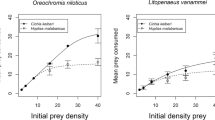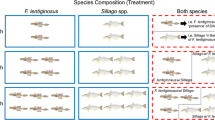Abstract
Mobile mesopredators can have strong influences in the structuring of marine food webs in shallow coastal ecosystems. Few quantitative estimates of the effects of predation on prey populations by highly mobile mesopredators exist, yet they are necessary to evaluate the impact mesopredators have on prey resources. Quantifying a predator’s functional response provides valuable information on how a predator’s per capita consumption rate of prey can influence community structure and prey populations. We examined the functional response of bonnetheads (Sphyrna tiburo) to one of its few natural prey items brown shrimp (Farfantepenaeus aztecus) to determine if per capita feeding rates would increase with increases in prey density. We simulated natural conditions in outdoor mesocosms and offered live prey at varying densities. The functional response of a predator can take one of three forms: linear (type I), rise to an asymptote (type II), and a sigmoid shape (type III). Bonnetheads consumed prey proportional to prey density and demonstrated a response that was in between a type I (R 2 = 0.847, p < 0.01) and type II (R 2 = 0.877, p < 0.01) functional response. Bonnetheads showed an increased rate of consumption with initial low prey densities but high densities of available prey did not consistently result in increased consumption rates. At the maximum prey density offered, bonnetheads consumed less prey than at intermediate densities. Bonnetheads may not have as strong of an influence on prey populations at high prey densities compared to predation impacts at low densities. Bonnethead per capita feeding rates did not conform to a type I, type II, or type III functional response and our results suggest that bonnetheads follow a functional response continuum more closely. This study highlights the importance and difficulty in understanding the feeding ecology of highly mobile mesopredators.


Similar content being viewed by others
References
Ajemian MJ, Powers SP (2012) Habitat-specific feeding in cownose rays Rhinoptera bonasus of the northern Gulf of Mexico. Environ Biol Fish 95:79–97
Ajemian MJ, Powers SP (2013) Foraging effects of cownose rays (Rhinoptera bonasus) along barrier island habitats of the northern Gulf of Mexico. J Exp Mar Biol Ecol 439:119–128
Bethea DM, Hale L, Carlson JK, Cortés E, Manire CA, Gelsleichter J (2007) Geographic and ontogenetic variation in the diet and daily ration of the bonnethead shark, Sphyrna tiburo, from the eastern Gulf of Mexico. Mar Biol 152:1009–1020
Buckel JA, Stoner AW (2000) Functional response and switching behavior of young-of-the-year piscivorous bluefish. J Exp Mar Biol Ecol 245:25–41
Carlson JK, Parsons GR (1997) Age and growth of the bonnethead shark, Sphyrna tiburo, from northwest Florida, with comments on clinal variation. Environ Biol Fish 50:331–341
Clark E, von Schmidt K (1965) Sharks of the central gulf coast of Florida. Bull Mar Sci 15:13–83
Compagno LJV (1984) FAO Species catalogue. Vol. 4. Sharks of the world: an annotated and illustrated catalogue of shark species known to date. Part 2. Carcharhiniformes. FAO Fish Synop 125:251–655
Cortés E (1999) Standardized diet compositions and trophic levels of sharks. ICES J Mar Sci 56:707–717
Cortés E, Manire CA, Hueter RE (1996) Diet, feeding habits, and diel feeding chronology of the bonnethead shark, Sphyrna tiburo, in Southwest Florida. Bull Mar Sci 58:353–367
Driggers WB, Campbell MD, Hoffmayer ER, Ingram GW (2012) Feeding chronology of six species of carcharhinid sharks in the western North Atlantic Ocean as inferred from longline capture data. Mar Ecol Prog Ser 465:185–192
Fogarty MJ, Murawski SA (1998) Large-scale disturbance and the structure of marine systems: fishery impacts on Georges Bank. Ecol Appl 8:S6–S22
Hassell MP (1978) Arthropod predator–prey systems. Princeton University Press, Princeton
Heithaus MR, Frid A, Wirsing AJ, Worm B (2008) Predicting ecological consequences of marine top predator declines. Trends Ecol Evol 23(4):202–210
Holling CS (1959) The components of predation as revealed by a study of small mammal predation of the European Pine Sawfly. Can Entomol 91:293–320
Lima SL (1998) Nonlethal effects in the ecology of predator–prey interactions. Bioscience 48:25–34
Lipcius RN, Hines AH (1986) Variable functional responses of a marine predator in dissimilar homogeneous microhabitats. Ecology 67:1361–1371
Moustahfid H, Tyrrell MC, Link JS, Nye JA, Smith BE, Gamble RJ (2010) Functional feeding responses of piscivorous fishes from the northeast US continental shelf. Oecologia 163:1059–1067
Myers RA, Baum JK, Shepherd TD, Powers SP, Peterson CH (2007) Cascading effects of the loss of apex predatory sharks from a coastal ocean. Science 315:1846–1850
Parsons GR (1993) Geographic variation in reproduction between two populations of the bonnethead shark, Sphyrna tiburo. Environ Biol Fish 38:25–35
Peterson CH, Fodrie FJ, Summerson HC, Powers SP (2001) Site-specific and density-dependent extinction of prey by schooling rays: generation of a population sink in top-quality habitat for bay scallops. Oecologia 129:349–356
R Core Team (2012) R: A language and environment for statistical computing. R Foundation for Statistical Computing, Vienna, Austria. ISBN 3-900051-07-0, URL http://www.R-project.org/
Real LA (1977) The kinetics of functional response. Am Nat 111:289–300
Real LA (1979) Ecological determinants of functional response. Ecology 60:481–485
Reeve A, Handy RD, Gruber SH (2009) Prey selection and functional response of juvenile lemon sharks Negaprion brevirostris. J Fish Biol 75:276–281
Rindone RR, Eggleston DB (2011) Predator–prey dynamics between recently established stone crabs (Menippe spp.) and oyster prey (Crassostrea virginica). J Exp Mar Biol Ecol 407:216–225
Rindorf A, Gislason H (2005) Functional and aggregative response of North Sea whiting. J Exp Mar Biol Ecol 324:1–19
Rudolf VHW (2008) Consequences of size structure in the prey for predator–prey dynamics: the composite functional response. J Anim Ecol 77:520–528
Solomon ME (1949) The natural control of animal populations. J Anim Ecol 18:1–35
Spitzer PM, Mattila J, Heck KL Jr (2000) The effects of vegetation density on the relative growth rates of juvenile pinfish, Lagodon rhomboides (Linneaus), in Big Lagoon, Florida. J Exp Mar Biol Ecol 244:67–86
Toscano BJ, Griffen BD (2013) Predator size interacts with habitat structure to determine the allometric scaling of the functional response. Oikos 122:454–462
Townsend CR, Risebrow AJ (1982) The influence of light level on the functional response of a zooplanktonivorous fish. Oecologia 53:293–295
Tyminski JP, Cortés E, Manire CA, Hueter RE (1999) Gastric evacuation and estimates of daily ration in the bonnethead shark, Sphyrna tiburo. American Society of Ichthyologists and Herpetologists. 79th Annual Meeting, Pennsylvania State University, University Park, June 24–30
Vucic-Pestic O, Rall BC, Kalinkat G, Brose U (2010) Allometric functional response model: body masses constrain interaction strengths. J Anim Ecol 79:249–256
Wetherbee BM, Cortés E (2004) Food consumption and feeding habits. In: Musick JA, Carrier JC, Heithaus M (eds) Biology of sharks and their relatives. CRC Press, Boca Raton, pp 223–244
Acknowledgments
This work was funded through the University of South Alabama and the Dauphin Island Sea Lab. The authors thank Matt Ajemian, Suni Chutkan, Brian Klimek and members of the Fisheries Ecology Laboratory for support in the field and Brian Cabral at the Dauphin Island Sea Lab for support at the mesocosm facility. We thank members of Discovery Hall Programs at the DISL for aid and cooperation in the collection of specimens. This manuscript was improved by insightful comments and suggestions by John Carlson, William Driggers III, Marcus Drymon, Ken Heck Jr., and three anonymous reviewers. This research is approved under the Institutional Animal Care and Use Committee (IACUC) protocol #11014.
Author information
Authors and Affiliations
Corresponding author
Rights and permissions
About this article
Cite this article
Kroetz, A.M., Powers, S.P. Eating between the lines: functional feeding response of bonnetheads (Sphyrna tiburo). Environ Biol Fish 98, 655–661 (2015). https://doi.org/10.1007/s10641-014-0302-3
Received:
Accepted:
Published:
Issue Date:
DOI: https://doi.org/10.1007/s10641-014-0302-3




